Feasibility Studies for Developing Energy Efficient Building in the Juet Campus Using Solar and Biomass Energy
1
Department of Civil Engineering,
Jaypee University of Engineering and Technology, Raghogarh,
Guna,
473226
Madhya Pradesh- 473226
India
2
Ujjain Engineering College,
Ujjain,
456010
Madhya Pradesh- 473226
3
Department of Civil Engineering,
Jaypee University of Engineering and Technology, Raghogarh,
Guna,
Madhya Pradesh- 473226
India
Corresponding author Email: abhishek.verma@juet.ac.in
DOI: http://dx.doi.org/10.12944/CWE.13.3.15
Building sector has been one of major contributors to global warming due to the excessive energy consumption during its lifecycle. In this context utilization of alternate energy resources such as solar, wind and biomass; as a replacement for conventional energy resources could be beneficially applied for achieving potential savings in power consumption. Adaptation of non- conventional energy resources combined with use of energy saving fixtures offer a sustainable solution for the increasing energy needs and environmental issues with conventional energy sources. In the present work feasibility studies were carried out for upgrading the existing building i.e. Annapurna bhawan in Jaypee University of Engineering & Technology (JUET), Madhya Pradesh, India; into an energy efficient building. Annapurna bhawan encompasses kitchen and four dining halls, being used for cooking and serving food to the students in the university. Study examines the potential benefits of using biomass energy through continuous anaerobic digestion and solar photovoltaic modules as a replacement to conventional energy sources. Results suggest potential energy savings and economic benefits could be achieved through the installation of these systems.
Copy the following to cite this article:
Verma A, Shankar Y. S, Bapna H, Kushwah L. S, Mudgal K. Feasibility Studies for Developing Energy Efficient Building in the Juet Campus Using Solar and Biomass Energy. Curr World Environ 2018;13(3).
DOI:http://dx.doi.org/10.12944/CWE.13.3.15
Copy the following to cite this URL:
Verma A, Shankar Y. S, Bapna H, Kushwah L. S, Mudgal K. Feasibility Studies for Developing Energy Efficient Building in the Juet Campus Using Solar and Biomass Energy. Curr World Environ 2018;13(3). Available from: https://bit.ly/2rw91oQ
Download article (pdf)
Citation Manager
Publish History
Select type of program for download
| Endnote EndNote format (Mac & Win) | |
| Reference Manager Ris format (Win only) | |
| Procite Ris format (Win only) | |
| Medlars Format | |
| RefWorks Format RefWorks format (Mac & Win) | |
| BibTex Format BibTex format (Mac & Win) |
Article Publishing History
| Received: | 2018-05-09 |
|---|---|
| Accepted: | 2018-10-24 |
| Reviewed by: | 
 Aditya Kumar Agarwal
Aditya Kumar Agarwal
|
| Second Review by: |

 Sonam Mishra
Sonam Mishra
|
Introduction
Importance of the renewable energy resources in the energy mix of the countries has been gaining importance worldwide. Growing population combined with increasing demand for domestic and industrial needs has been exerting huge stress on the energy sector. The environmental issues such as global warming, ozone layer depletion, climate change etc; warrant the utilization of conventional energy resources and emphasize the need for clean fuels in energy mix.1 The problem is more critical in developing economies like India, being second largest populous country in the world and predominantly driven by coal based energy.2,3
Sustainable energy resources have been the major necessity in policy framework for reducing the negative impacts of conventional energy resources. Renewable energy resources such as solar, wind, biomass, tidal, wave and geothermal, could be used as an alternative or in combination with conventional energy resources for reducing the magnitude of these impacts.4,5 In India the affects of higher consumption of coal has resulted in significant impact on ecology due to exploitation of coal reserves and residues on consumption. Additionally the inferior quality of coal containing higher ash content has been responsible for the deterioration of the atmosphere in surrounding areas through air pollution. In order overcome these problems use of alternate non- conventional resources based on their availability could be the feasible solution. In the Indian scenario, solar energy is available in abundance in majority of the regions as the global solar radiation incident over India ranges from 1200 to 2300 kWh/m2/year with about 300 clear sunny days.6,7,8,9,10,11
Energy consumption in buildings could be the feasible area for optimizing the consumption as the buildings demand huge energy inputs throughout its life cycle (construction, utility and demolition). Studies have pointed out that globally 30- 40% of the energy is consumed by buildings being responsible for 40- 50% of greenhouse gas emissions. Negative foot print of the buildings could be minimized through choice of suitable materials, technology, including the renewable energy resources and electrical devices enhancing the energy efficiency. Optimizing the energy consumption through these active and/or passive technologies provides energy savings, economic and environmental sustainability in the longer run.12,13,14,15
Universities offering a variety of courses in various domains have a greater role to play in this domain through conservation of environment by promoting multi- disciplinary research. University administration could propagate the concept of environmental sustainability to students through encouraging policies such as recycling of wastes, energy conservation, use of natural resources, enhancing greenery and adopting the green principles in design, construction and operation of buildings.16,17,18,19 Research work undertaken by Jain and Pant (2010) at TERI University, New Delhi, India; have proposed model for environmental management in the university through case study of their campus. Study was mainly focused taking ISO 14001 guidelines into the consideration. The key areas that were identified in the work for effective environmental management in the campus were waste management and energy efficiency.20 Considering the points mentioned above, the present work was primarily focused on optimizing the energy consumption in building named Annapurna bhawan in the JUET campus, used for cooking and serving food to the students of the campus.
Study Area
The study area discussed in the present work is Jaypee University of Engineering & Technology (JUET), established by Jaiprakash Sewa Sansthan (JSS). JUET is located at Raghogarh, on Agra- Mumbai national highway, Guna district, Madhya Pradesh, India. University is spread in an area of 125 acres, housing a population more than 3000 inside the campus through hostels for students and residential accommodation to faculty and staff. Presently, the university has been offering various courses at graduate, post graduate and doctoral level in the field of engineering and sciences. Layout of buildings in university consisting of academic buildings, residential areas, mess, shopping complex and hostels as shown in Fig.1. Annapurna bhawan (indicated as Mess in the Fig.1) was considered in the study for optimizing the energy utility in the building using biomass and solar energy due to the following reasons:
Buildings in the university were designed in a manner that enhances the natural ventilation and air movement, providing energy efficiency in building utility. Additionally the university has greater area of plant cover, rainwater harvesting system (collecting the rainwater from all areas through lake, Fig.1) and reusing the domestic wastewater in the campus.
University has three dining areas, two kitchens (separate for the students and working staff) generating food waste (vegetable and fruit peels, discarded food); additionally residential areas, vegetable grocery and café in the campus add up to considerable quantity of organic waste generated from the campus, offering the benefits for productive utility. Waste generated from the different sources is being collected separately, that provides the advantage of easy segregation of waste.
Mode of cooking in the university is mostly mechanized (energy exhaustive), highlighting the need for replacement with non-conventional energy sources.
The region where the university exists was identified as potential area by Madhya Pradesh Trade and Investment Facilitation Corporation, for solar power generation with radiation in range of 5.6- 5.8 kWh/sqm/day with longer duration of clear sun.21
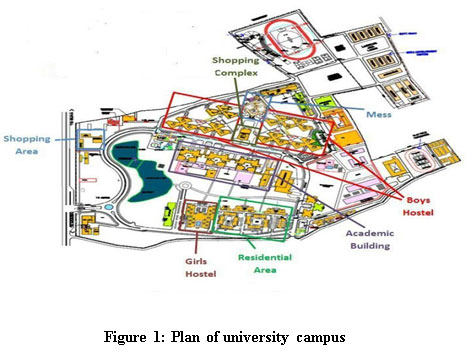 |
Figure 1: Plan of university campus |
The following objectives were framed in the study
To analyze the existing energy utilization scenario in Annapurna Bhawan, JUET; for understanding the feasible options in developing energy efficient building.
To evaluate the potential of food waste generated in the campus for installation of biogas plant.
To study the benefits of harnessing the solar energy through suitable applications.
Analysis and comparison of results obtained for deciding possible options in developing energy efficient building.
Methodology
The work has been broadly undertaken as shown in Fig.2.
 |
Figure 2: Methodology adopted |
Sample Collection
For the residential areas the solid waste is being collected daily, on a door to door basis in the morning. Collected waste from different residential quarters is transferred to large bins prior to transportation; representative sample was collected at this juncture by emptying all bins on to the ground; after thorough mixing of sample. Then the sample was quartered and the quartered sample was quartered again to obtain representative sample. In case of mess, the sample was collected after the preparation of meal to the students in the afternoon that includes the food waste generated due to preparation of breakfast and lunch.
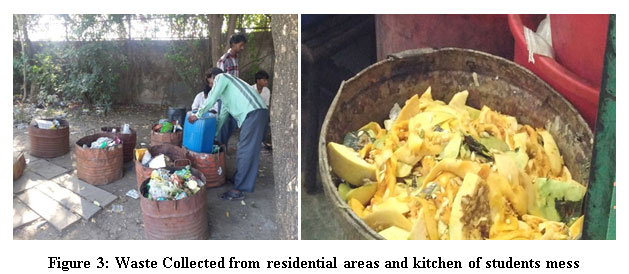 |
Figure 3: Waste Collected from residential areas and kitchen of students mess |
Methods 22
All the waste samples were immediately analyzed to determine the composition of the waste at the source itself, using spring balance. For the sample collected from the mess, food waste was further analysed to estimate its characteristics for the beneficial processing and utilization. Food waste sample was analyzed for parameters such as moisture content, pH, volatile matter and fixed carbon.
Waste composition
Individual composition was analyzed through separation of different fractions from the representative sample and weighing these fractions.
Moisture content
Moisture content was determined as percentage change in mass after oven drying at 1050C for one hour.
Volatile matter and fixed carbon content
Volatile matter (and fixed carbon content) was determined by loss on ignition at 6000C in muffle furnace for two hours. Fixed carbon content was estimated through the combustible residue left after volatile matter was removed.
pH
pH was measured using digital pH meter (glass electrode), by dissolving 10g of solid waste in 500 ml of distilled water and allowing it to settle for five minutes.
Data collection
Cooking areas (for students and working staff) were found to be the major contributor of food waste in form of vegetable peels, fruit peels etc. Data was collected for one year span to accommodate the changes in quantity of generation during the vacation for students. An average quantity of 100 kilograms per day was being generated on working days and 15 kilograms per day during the vacation to the students. From the residential areas, food waste quantity around 100 kilograms per day was observed. Sources such as cafeteria and vegetable grocery store, contribute to minor quantities, on a daily basis.
For understanding the feasibility for utilizing the solar energy applications the present study has adopted the temperature data collected at study area by Pandey et al., (2015)26 using Environtech wind monitor (WM 271) existing in the environmental engineering laboratory of the university. The data was collected by the authors throughout the year on daily basis (hourly data). The collected data was applied in estimating the number of sunny days on the basis of number of days in the year having temperature 25 oC (this temperature has been considered as PV modules operate at their rated efficiency at the temperature above this value). Solar energy conversion takes place through solar cell, a number of such cells connected together form a PV module. PV modules can be either, stand alone, grid connected or hybrid systems. Inverters are required for converting direct current to alternating current. The performance of PV modules are rated according to operating temperature of 25 oC, spectral distribution of AM 1.5 and an incident solar irradiance of 100 W/m2.28
Biogas Digester
Biogas digester was developed for the testing purpose, with drum of 200 litres capacity (as shown in Fig.4). The drum was checked to ensure uniform inner surface, inlet and outlet arrangements were added later. The tests were conducted in two trials in the first trial; the biogas digester was initiated with organic waste collected from sources such as mess, cafeteria, residential area and vegetable grocery store in proportion to quantity of generation (predominantly upto 90% from residential areas and mess, 10% from grocery store and cafe in equal amounts). In the second trial only the waste from mess predominantly consisting of vegetable and fruit peels was subjected to anaerobic digestion in the digester. For satisfactory anaerobic digestion the solids concentration was maintained as 9 parts per 100 parts of the slurry.9 pH was monitored on alternate days upto 24 days and potential of biogas quality was assessed using syringe method. In the syringe method, the concentration of methane gas generated during anaerobic digestion was measured through absorbing CO2 gas in an NaOH liquid. Sample was collected on a regular alternate day basis using the syringe and outlet of the syringe was connected through a tube to NaOH liquid in a beaker. Volume of gas remaining after absorption of CO2 was estimated as volume of methane. It was also checked with the brightness of the flame to understand methane gas release.23 The performance of the reactor was studied at location where the temperature variations were little and room temperature existed for most of the time.
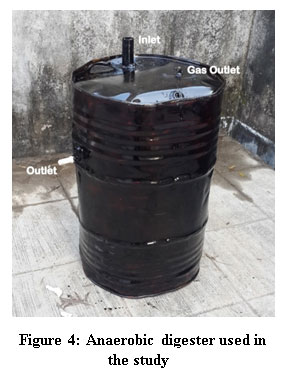 |
Figure 4: Anaerobic digester |
Results and Discussion
Analysis of Waste Samples
Individual composition of the waste sample collected from the residential areas suggested the predominance of organic waste upto 65% (as shown in Fig.5). For the sample collected from the mess the composition predominantly consisted of food waste with proportions of vegetable and fruit peels (upto 90%), only small concentrations of other packing material, plastics and paper were observed.
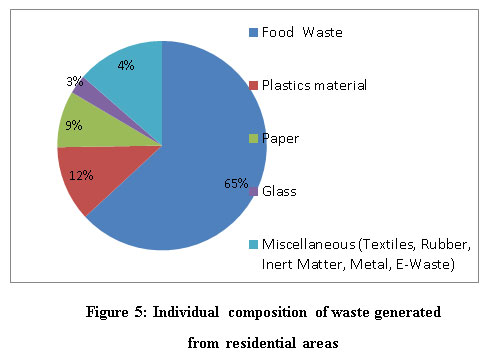 |
Figure 5: Individual composition of waste generated from residential areas |
The results of analysis of the food waste sample collected from the mess shows the feasibility for anaerobic digestion (as shown in the Table 1), the obtained values were compared with desirable range prescribed as per standards.24 Anaerobic decomposition proceeds in two stages acid formers and methane formers. pH plays an important role for obtaining the required outcome.25 pH of waste was observed to be in a neutral range, providing the optimum conditions for fluctuation during anaerobic decomposition.
Table 1: Results of organic waste sample collected from mess
|
Parameter |
Obtained Value |
Desirable range 24 |
|
Moisture content (%) |
56 |
>50 |
|
Volataile matter (%) |
44 |
>40 |
|
Fixed carbon (%) |
12 |
Not significant |
|
pH |
7.3 |
Neutral pH |
Working of Anaerobic Digester
In the study pH was observed to be limiting step in general during the anaerobic digestion, but the influence was found to be higher in trial 1 affecting the efficiency of the process. The results suggest that, by the end of 8 days after the initiation, pH has shown drop from 7.1 to 5.2. The gas produced has shown slight bluish flame even at the end of 10 days, showing the predominance of CO2 gas. Syringe test results have also shown the higher content of CO2 at that time. Methane gas volume increased (i.e. greater than 50% of total gas released) after 14 days which decreased after 22 days. In trial 2 the efficiency of the system has increased due to the lesser fluctuations in pH. pH has varied from 7.3 to 6.1 after 8 days but the major difference was observed with respect to the production of methane gas (i.e. greater than 50%), that was observed after 12 days, the volumetrically the gas production rate was much higher as compared to trial 1, throughout the study. After 12 days itself a bright flame was observed and fluid level in syringe has indicated lesser absorption of CO2 indicating the higher composition of methane.
The following were the main reasons for the variation in the biogas composition and pH; in trial 2 the waste collected from the mess entirely consisted of fruit and vegetable peels whereas in the trial 1 the waste composition varied in addition to peels, packed food, discarded food containing butter, cheese and other inert fractions such as paper plates, wrapping covers or plastics etc. Though the waste was processed to consider only the food waste fraction but the variation in moisture content and presence of minute quantities of other fractions; was observed to be the major parameter influencing the rate of anaerobic decomposition. The study has pointed the fact that effective utilization could be feasible through the implementation of two bin system at these sources for reducing the influence of other compositions. Well operated digester maintaining the optimum parameters for operation could provide continuous productive output.
Solar Energy Potential
Results of data collected by Pandey et al., (2015)26 suggest that an average value of 6 hours (above temperature 25 oC) in 300 sunny days was observed. Average solar irradiation data of the region collected from national solar radiation data base27 suggest potential of 5.6- 5.8 kwh per sq m. Fig. 6 shows the diurnal variations in temperature for all the months, data represented in the fig. was collected randomly during the third week of each month. Results suggest that temperatures are quite favorable throughout the year, for productive utilization. Maximum potential for the utilization was observed during the months of April, May and June, with temperature above 25 oC for a duration of about 8 hours and it was observed to be least during colder months starting from November to February. Applications could be extended to water heaters, cookers besides conversion to electricity.
Total rooftop area available over Annapurna bhawan is 2378 square meters, the field inspection and measurements undertaken suggest that 50-60% of the area can be utilized for solar panel installation (i.e. 1307.9 sqm). Usable area was shown in yellow, uncoloured area indicates presence of ducts/ machinery etc, blue and green shades indicate the presence of vegetation and fountain as indicated in Fig 7. Certain area has not been considered that is overshadowed by water tank. Study has estimated through utilization of PV modules power generation upto 19000 units could be feasible per month, enhancing the energy savings and carbon foot print.
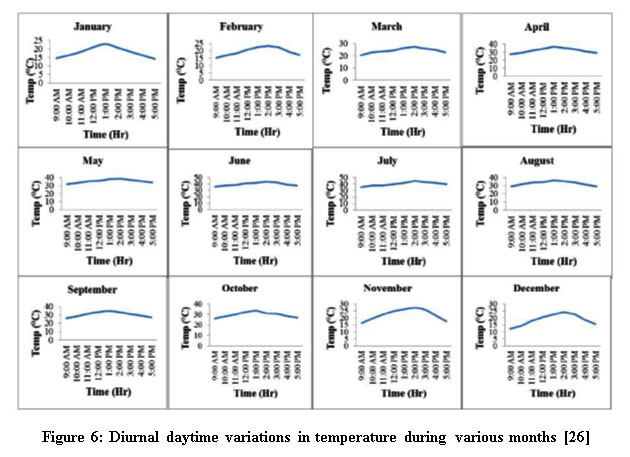 |
Figure 6: Diurnal daytime variations in temperature during various months 26 |
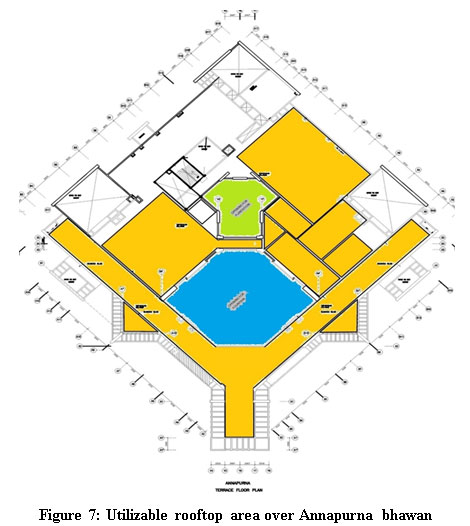 |
Figure 7: Utilizable rooftop area over Annapurna bhawan |
Conclusions and Discussion
The present work outlines feasibility of utilizing the biomass energy and solar energy for converting existing building into energy efficient building. The following were conclusions drawn from the study:
Temperature of the study area was observed to be the useful parameter that permits effective applicability for utilization of solar energy and biomass energy.
Presently the following energy exhaustive equipment were being used in combination with conventional LPG based cooking: dish washer, cutting machine, grinder, peeling machine, boiler plant, insect killer, bread toaster and making oven, cold store etc; that could be well supplemented with biogas and solar energy based appliances providing ecological and economic benefits.
The food waste generated from the mess suggests higher feasibility through biochemical conversion. Biochemical conversion using anaerobic digester under favourable operational parameters such as pH and moisture content could significantly reduce the LPG consumption in the building. Installation of Biogas plant of 1000 litre capacity will help to replace 4482.76 litre of LPG per month and hence a saving of INR 141864.73 in a month approximately.
Installation of PV modules on available rooftop area of 1307.9 m2 will help to minimize power consumption by 19015 units per month approximately. University has a separate substation; hence incorporation of solar photo voltaic modules for electricity generation can be directly connected to the grid. A total saving of approximately INR 2.5 lakh per month (through reduced electricity and LPG consumption) on installation of biogas and solar energy harnessing equipments in Annapurna mess.
Installation of energy efficient passive fixtures further optimizes the power consumption. Adaptation of such practices provides advantages like sustainable use of resources, better environmental quality, motivation to students and overall reduced cost of operations and maintenance.
Suggestions
The present study discusses about the feasible options that could be incorporated for developing energy efficient building. The following aspects were not considered in the study that needs further study:
Choice of suitable solar module offering wide range of applications from solar cookers to water heater and electricity generation that could be installed in the building and its orientation.
Scope of passive energy saving fixtures and their associated benefits enhancing energy efficiency.
Study could be further extended to the utilization of certain types of garden waste as bio-digester ingredient in combination of with food waste due to greater area of plant cover in the campus.
The present study could well be extended with an understanding of the influence of atmospheric temperature on process parameters considering seasonal variation.
References
- L.Pe´rez-Lombard., J.Ortiz., C.Pout. “A Review on Buildings Energy Consumption Information”, Energy and Buildings. 2008;40:394–398.
CrossRef - Vij.D. “Urbanization and Solid Waste Management in India: Present Practices and Future Challenges”, Procedia - Social and Behavioral Sciences. 2012;37:437 – 447.
CrossRef - Central Electric Authority (CEA) (2016) ‘All India installed capacity (in mw) of power stations (As on 31.05.2016) (Utilities)’, Government of India [Online] http://www.cea.nic.in/reports/monthly/installedcapacity/2016/installed_capacity-05.pdf
- Garg.P. “Energy scenario and vision 2020 in India”, Journal of Sustainable Energy & Environment. 2012;3:7-17.
- Kamkan N., Bercin K., Cangul O., Morales M. G., Kulam, M. M., Saleem M., Marji I., Metaxa. ”A renewable energy solution for high field campus of university of south ampton”, Renewable and Sustainable Energy Reviews. 2011;15(6):2940–2959.
CrossRef - Pillai I. R., Banerjee R. ”Renewable energy in India: Status and potential”, Energy. 2009;34:970–980.
CrossRef - Sudhakar.K. and Srivastava.T, “Energy and exergy analysis of 36W solar photovoltaic module”, International Journal of Ambient Energy. 2012;35 (1):51-57.
CrossRef - Ramachandra T. V., Jain R., Krishnadas G. “Hotspots of solar potential in India”, Renewable Sustainable Energy Reviews. 2011;15 (6):3178–3186.
CrossRef - Saeed S. S., Sharma D. K. (2012), Non- conventional energy resources, S.k. Kataria & Sons, ISBN-13:9789350142288. 2014. Guttikunda S. K., Jawahar P. “Atmospheric emissions and pollution from the coal-fired thermal power plants in India”, Atmospheric Environment. 2014;92:449- 460.
CrossRef - Shahbaz M., Farhani S., Ozturk I. “Do coal consumption and industrial development increase environmental degradation in China and India?”, Environmental Science and Pollution Research. 2015;22:3895–3907.
CrossRef - Life cycle energy analysis of buildings: An overview T. Ramesh, Ravi Prakash, K.K. Shukla Energy and Buildings. 2010;42:1592–1600.
CrossRef - D. Kolokotsa., D. Rovas., E. Kosmatopoulos., K. Kalaitzakis. “A roadmap towards intelligent net zero- and positive-energy buildings” Solar Energy. 2011;85(12):3067–3084.
CrossRef - I.Sartori., A. G. Hestnes” Energy use in the life cycle of conventional and low-energy buildings: A review article” Energy and Buildings. 2007;39:249–257.
​​​​​​​CrossRef - Life-cycle carbon and cost analysis of energy efficiency measures in new commercial buildings Joshua Kneifel Energy and Buildings. 2010;42:333–340. Azucena E., Sonia B., Héctor J., Daniel C., Mireya I., Claudia S. “Energy consumption and GHG emission scenarios of a university campus in Mexico.” Energ. For Sust. Dev. 15:2940– 2959.
- Habib M. A., Ismaila A. “An integrated approach to achieving campus sustainability: assessment of the current campus environmental management practices.” J. Cleaner Prod. 2008;16(16):1777-1785.
​​​​​​​CrossRef - Shahrom M. Z., Noor E. A., Basria., Hassan B., Norhidayu Z., Rahmah E., Maisarah A., Tiew K. G., Zarina S., Sarifah Y., Ismi A.. I. K. “Focusing on recycling practice to Promote sustainable behavior.” Procedia – Soc. Beh. Sci. 201260:546–55.
- Wong N. H., Steve K. J., Aung A. L. W., Htun K. T., To S. N., Wu X. “Environmental study of the impact of greenery in an institutional campus in the tropics.” Building & Env. 2007;42(8):2949–2970.
​​​​​​​CrossRef - ain S., Pant P. “Environmental management systems for educational institutions: A case study of TERI University, New Delhi”, International Journal of Sustainability in Higher Education. 2010;11(3):236-249.
​​​​​​​CrossRef - Madhya Pradesh Trade and Investment Facilitation Corporation (MPTRIFAC). (2017). < www.invest.mp.gov.in > Bureau of Indian Standards (BIS) (1982), “Methods of analysis of solid wastes”, IS: 10158. A.J. Guwy Equipment used for testing anaerobic biodegradability and activity Reviews in Environmental Science and BioTechnology. 2004;3:131–139.
CrossRef - Ministry of Urban Development (MOUD) (2000), “Manual on solid waste management”, Published by Ministry of Urban Development, Government of India. Available at: http://moud.gov.in/advisory/swm_manual. Peavy H. S., Rowe D. R., Tchobanoglous G. “Environmental engineering.”McGraw Hill International Editions, Civil Engineering Series, ISBN 0-07-1002316. 1985.
- A. Pandey., Y. S. Shankar A., Saxena., R Khandelwal. “Harnessing solar energy for sustainable energy management in the campus: case study of Juet, Guna”, Discovery. 2015;41(190):156-162.
- National Solar Radiation Data Base (NSRDB) National Renewable Engineering Laboratory, 2017 Details available at https://nsrdb.nrel.gov/ Zeman M. Photo voltaic systems. Chapter 9 (Solar cells) Available online at http://ocw.tudelft.nl/fileadmin/ocw/courses/SolarCells/res00029/CH9_Photovoltaic_systems.pdf. 2015.






